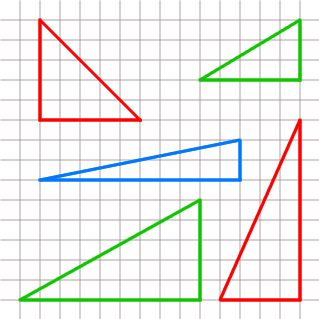Copyright © University of Cambridge. All rights reserved.
'Uncanny Triangles' printed from https://nrich.maths.org/
Uncanny Triangles
Thomas, Jane and Anna were drawing right angled triangles on squared paper. Their triangles had two sides which were an exact number of squares long and could not be longer than $15$ squares. These are Jane's triangles:

They were calculating the areas of the triangles.
"I've got one triangle where the area and the sum of the lengths of the two shorter sides come to exactly the same number!" exclaimed Anna, "Look, it's that one!"
Thomas looked at his work. "How uncanny - but so have I! But look at it. It's quite a different shape from yours."
What were the measurements of the triangles they had drawn?
Why do this problem?
This problem needs a systematic approach. It is useful when learners are studying the area of right-angled triangles. It is important to remember that it is only the
two shorter sides of the triangles that are being considered in the problem, not all three sides.
Possible approach
Most learners will need to draw some right-angled triangles on squared paper to get a feel for the problem.
Key questions
Where is a good place to start?
Have you looked at some of the examples given in the problem?
Do you need to draw all possible triangles to see if any meet the requirements?
If you double the length of the sides how does the area change?
Possible extension
Learners could consider fractional measures or look for triangles where the sum of the
three sides is numerically equal to the area.
Possible support
Suggest drawing some right-angled triangles on squared paper and counting the squares to find the area.
